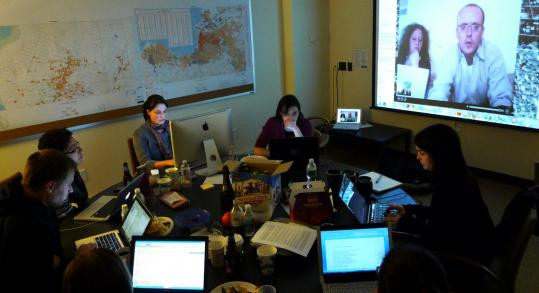
Date: 2024-09-27 Page is: DBtxt003.php txt00019991
Mapping
Ushahidi Crisis Mapping
Patrick Meier (on screen) and Tufts volunteers ran a crisis-mapping website to help Haiti.
Peter Burgess

Patrick Meier (on screen) and Tufts volunteers ran a crisis-mapping website to help Haiti. (Carol Waters)
MEDFORD — Almost from the moment the Jan. 12 earthquake rocked Haiti, Tufts University graduate student Patrick Meier knew what he had to do to help: Make a map.
Not a street map, but an online map pinpointing people in need and ways to help them: Children trapped in a collapsed school screaming for help; an 80-year-old woman with a crushed leg who needed evacuation; the location of a drum of water-purifying solution.
Meier enlisted hundreds of tech-savvy colleagues at the Fletcher School of Law and Diplomacy to translate data moving via text messages and social media networks into an online resource, showing real-time updates on where help was most urgently needed or available.
Aid workers quickly saw the value of Meier’s creation. “This really helped us get the aid exactly where it was needed,’’ said Craig Clarke, a civilian intelligence analyst for the Marine Corps. “What they did was beyond valuable. It was gold.’’
Clarke, who helped the Ma rines deploy and operate in Haiti from his intelligence base at Quantico, Va., said he had no doubt that the crisis-mapping operation helped to save lives and get crucial aid to thousands of Haitians in the weeks after the quake.
And now the project may even become even more valuable as the focus lurches from rescue to recovery and rebuilding. In building his Haiti map, Meier drew on technology developed by a multinational group called Ushahidi, in which volunteers painstakingly calculate precise longitude and latitude readings to locate incidents reported during crises on the radio, or via e-mail, Twitter, and other social media. Launched by activists in Kenya after election violence in December 2007, Ushahidi — Swahili for “testimony’’ — has already proved vital in several global crises and trouble spots, especially in Africa. Ushahidi-Haiti has grown dramatically from its first days in Meier’s dorm room, and, later, its home in windowless basement “situation room’’ on campus. At the Fletcher campus nine days ago, Ushahidi leaders trained Boston-area Haitians for the next phase. And near Port-au-Prince over the weekend, Haitians from a nonprofit group neighborhood activist group called Block by Block were working with Ushahidi-Haiti members to turn their own detailed neighborhood surveys into online maps of need. “It’s a very amazing idea,’’ said James Douglass Lefruy, a Haitian computer programmer who is a Block by Block leader in Croix-des-Bouquets, just outside the capital, speaking by cellphone from his hometown. “If the problem is water, or electricity, then you can map exactly which regions have the problem. And it can be used not only for crises, but for other purposes, too.’’ One reason for Ushahidi-Haiti’s success lies in the profile of the Fletcher School’s graduate students, who, with an average age of 28, already have an impressive range of global experience. Fletcher’s academic dean, Peter Uvin, said, “if you look at the crowd who took early leadership, they all have prior, relevant experience; Patrick had done early-warning work in the Horn of Africa for years. They don’t start from scratch.’’Continued...